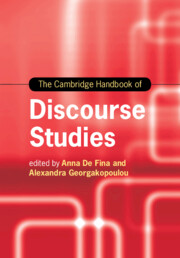Book contents
- The Cambridge Handbook of Discourse Studies
- Cambridge Handbooks in Language and Linguistics
- The Cambridge Handbook of Discourse Studies
- Copyright page
- Contents
- Figures
- Tables
- Contributors
- Preface
- Part I (Con)Textualizing Discourses
- Part II Perspectives and Modes of Analysis
- Part III Discourse Materialities and Embodiment
- 12 Multimodality
- 13 Sign Theory and the Materiality of Discourse
- 14 Discourse and the Linguistic Landscape
- 15 Discourse, Emotions and Embodiment
- 16 Posthumanism and Its Implications for Discourse Studies
- Part IV (Trans)Locations and Intersections
- Part V Ethics, Inequality and Inclusion
- Part VI Discourses, Publics and Mediatization
- Index
- References
13 - Sign Theory and the Materiality of Discourse
from Part III - Discourse Materialities and Embodiment
Published online by Cambridge University Press: 28 September 2020
- The Cambridge Handbook of Discourse Studies
- Cambridge Handbooks in Language and Linguistics
- The Cambridge Handbook of Discourse Studies
- Copyright page
- Contents
- Figures
- Tables
- Contributors
- Preface
- Part I (Con)Textualizing Discourses
- Part II Perspectives and Modes of Analysis
- Part III Discourse Materialities and Embodiment
- 12 Multimodality
- 13 Sign Theory and the Materiality of Discourse
- 14 Discourse and the Linguistic Landscape
- 15 Discourse, Emotions and Embodiment
- 16 Posthumanism and Its Implications for Discourse Studies
- Part IV (Trans)Locations and Intersections
- Part V Ethics, Inequality and Inclusion
- Part VI Discourses, Publics and Mediatization
- Index
- References
Summary
A consideration of the “materiality of discourse” necessarily implicates a reexamination of some fundamental contributions to sign theory. Here, I first review the theoretical writings of Saussure, Volosinov and Peirce, comparing their various approaches to the problem of the sign and to semiosis. Peirce’s insistence on the importance of “secondness” (i.e. sigsigns, indexes, dicents) suggests a way of thinking about discourse that does not involve positioning it, either as representational medium or as social effect, in isolation from the material contexts in which it is used (and of which it is, in fact, a part). Drawing on some contemporary work in linguistic anthropology, I aim to illustrate this approach through a discussion of a few particularly perspicuous, ethnographic examples.
Keywords
- Type
- Chapter
- Information
- The Cambridge Handbook of Discourse Studies , pp. 282 - 305Publisher: Cambridge University PressPrint publication year: 2020
References
Further Reading
This very useful introductory essay is partly concerned with the semiotic mediation of material qualities.
Goodwin’s magnum opus brings together his lifelong concern with gesture, materiality, language and embodiment in an argument about the cooperative character of human action.
This is an important attempt to apply the linguistic anthropological approach to the study of documents in their contexts of use.
In this classic, pioneering essay, the author explores ways of thinking about language across a range of contexts and challenges a simplistic application of Saussurean sign theory to the ethnographic study of language in context.
This is an important and influential intervention in which the author shows the utility of Peircean sign theory in a semiotic consideration of material objects.
In this short but brilliant comment on Hull’s ethnography, the author draws upon Derrida and some of the ethnographic details Hull reports on to articulate larger questions about the relationships among language, discourse and materiality.
This is a useful, recent and quite comprehensive survey of Peirce’s writings on signs.



